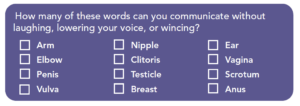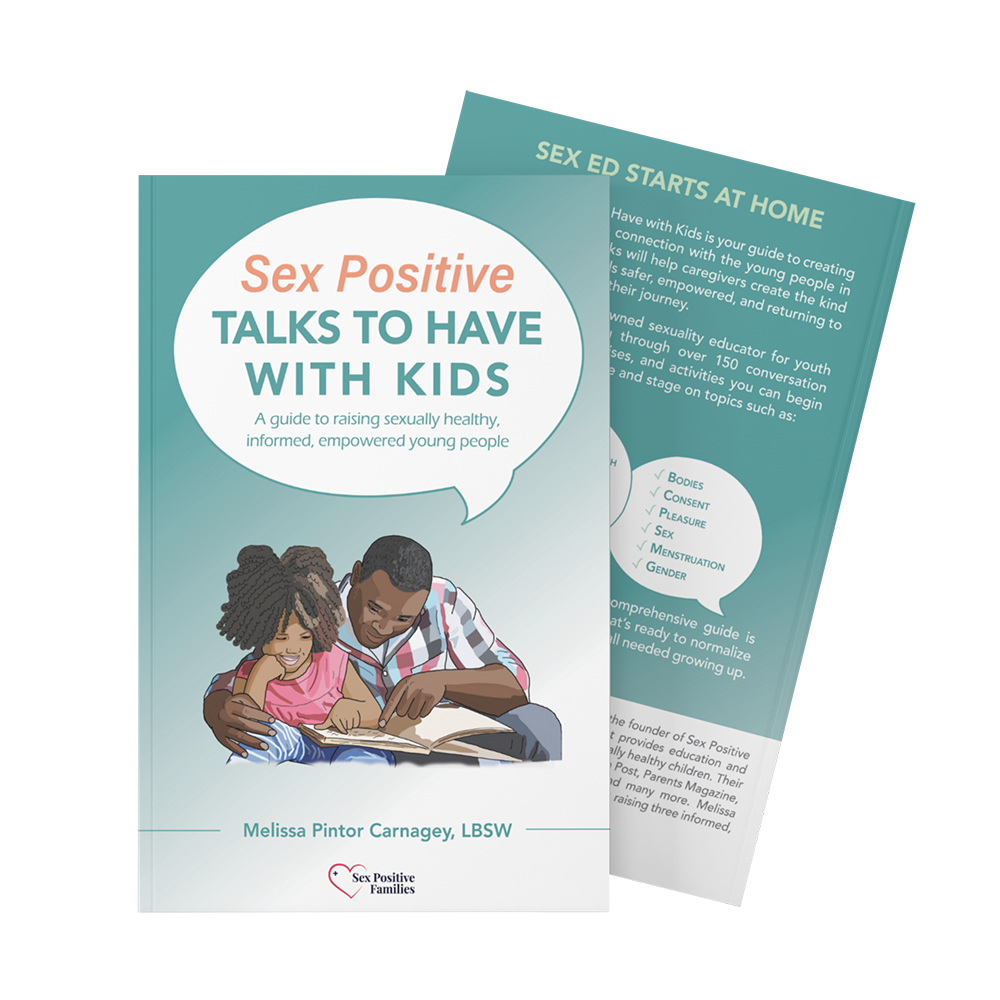– By: Melissa Pintor Carnagey, LBSW –
Growing up, what messaging did you receive about bodies?
Did it include…
- Images dictating what an attractive or desirable body should look like?
- Messaging that bodily functions, like menstruation, are gross?
- The idea that genitals, aka ‘private parts,’ are dirty?
If so, you’re definitely not alone.
Many of us were raised to feel at war with our bodies or to see our body as unpredictable, wild, and something we must control. Taken to extremes, this can manifest into harmful outcomes like fear of physical intimacy, shame over typical bodily functions (such as menstruation and erections), disordered eating, and a negative self-image.
As parents and caring adults, we have the opportunity to break the cycle and help instill positive body messaging into our children, offering empowering support as their bodies are changing. Where can we start? Here are five ways to help children feel thankful for their bodies and more confident in their own skin.
Teach them accurate words for body parts
Many of us grew up in homes and within education systems that did not normalize bodies or provide accurate information. How can we appreciate our bodies if we don’t understand them and can’t speak about them? This contradiction can lead to body discomfort that can seep into our language, giving children the impression that some parts are inherently wrong or shameful.
For example, it’s easy for most of us to talk with children about their arms or their knees. But instead of referring to your child’s vulva or penis, you might have been conditioned to use phrases like “down there,” “lady parts,” “junk” or to give it a euphemism (some of which are quite interesting!) like their “hoo-ha,” “bits,” “willie,” or “ding dong.”
Words like these may make us laugh…but it’s often laughter to take the edge off discomfort. And that’s learned discomfort that a child can sense.
The great thing is that you are now able to create better possibilities for a child in your world. Try this challenge to gauge where you’re at, reading each word out loud:

If you noticed a difference in your reactions to the words society tends to correlate with sex, versus the non-sexualized words, this can be a sign that you’ve internalized messaging that can affect your comfort level when thinking or talking about these body parts. If that’s the case for you, hold compassion. With practice, you can shift this. Practice until there’s no hesitation, and remember that you’re growing, too.
Affirm the important jobs of each body part
Many of us have been trained to react to our body’s essential roles with one word only: “eww.” These reactions can follow people into adulthood, making it difficult to experience natural bodily functions without feeling the urge to hide or hold judgment.
Let’s say your child has a bowel movement. Rather than making a joke about the smell or speaking of it as something gross, consider an affirming response like “Your body did its job!” or “Feel better now?” This helps children understand that bowel movements serve an important function and typically improve the way we feel: a positive thing!
As a child enters puberty, we can also affirm the unique abilities of genital anatomy, helping them understand experiences like erections, nocturnal emissions (wet dreams), and pubic hair growth. All three of these experiences, by the way, are not just things that happen to people with a penis. Clitorises can become erect, vaginas can secrete fluids during sleep, and vulvas can grow hair too!
Normalize menstruation when talking to all young people
Growing up, did you hear negative comments like “must be on the rag!” or observe others hiding their menstrual products or did you see people reacting to menstrual blood as something “gross”? These are common ways children learn to view menstruation as shameful and undesired.
We can model something different, so children learn to see periods as what they actually are: a powerful bodily process! A great way to start is by educating ourselves about menstruation, and how it truly works.
It’s important that people who menstruate are supported and respected. Moreover, young people of all genders need to know what is involved with menstruation: this helps them develop a shame-free understanding of bodies, people with uteruses, reproductive health, and human rights.
The depth of information you share with a child can vary by age, curiosity, and their level of understanding. In the Menstruation section of our resources page, you’ll find inclusive videos, books, podcasts, comics and more to foster engaging talks and learning in your home.
All bodies = good bodies
As young people grow into tweens, they will encounter changes to their bodies. Keeping an open dialogue is the best way to prepare them for greater confidence, especially if you encourage their curiosity.

Here’s a sample script you can use with a child in this age group (roughly 9-12 years old):
“It’s common to wonder, is my body normal? Remember that bodies are uniquely designed and all bodies are good bodies. If you ever have questions about your own body, let me know so I can help answer them.”
Your child will witness many different messages in the world about bodies, that can influence their body image.
Don’t underestimate the significant role you have in countering negative messaging and offering empowering alternatives.
Additionally, with media literacy skills, you can prepare your child to navigate body messaging with a healthy lens. Finally, the way you talk about yourself matters. Let them observe you being appreciative of your body, using affirming statements like:
- “I like my body as it is right now.”
- “My body is wise. I trust what it tells me.”
- “I am grateful for my body.”
Be transparent about pleasure
Pleasure is an integral part of being human, and yet so many of us have been raised within cultures that attach guilt to it. This doesn’t have to be the case for the next generation.
It’s critical to help children understand that “private” does not equal “shameful.” Let’s say you want to address masturbation and self-touch. “It can feel good to touch our own genitals,” you might say. “We do this in private. If you want to enjoy self-touching, you can go to [name of private space].”
Did you pick up on the nuances in that script? It pairs words like “good” and “private,” to let children know that just because self-touch is best explored in a private environment does not mean it’s wrong. The truth is, most people engage in activities like masturbation or partnered sex because it feels good. When we’re honest with children about the fact that our bodies are designed with nerve endings in our genitals (and elsewhere!) that register pleasure, it takes the taboo out of masturbation, and helps them develop a more informed understanding of what touch feels good. And, what touch doesn’t. This is also what can keep them safer and better prepared to recognize and communicate their body boundaries and needs.
Helping a child feel thankful for their bodies is an ongoing process. Not one talk or action, but many teachable moments over time. As you create a shame-free home culture around bodies and body parts, you may find yourself shedding some old beliefs and picking up new ones that better align with who you are today. It’s a win-win for the whole family.

Sex Positive Talks to Have With Kids is the bestselling guide to creating an open, shame-free connection with the young people in your world.
It’s an inclusive, medically accurate, and comprehensive resource that walks you through over 150 conversation starters, reflection exercises, and activities you can begin implementing at every age and stage to normalize sexual health talks and become the trusted adult we all needed growing up.
